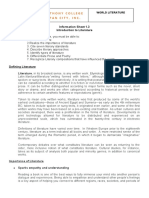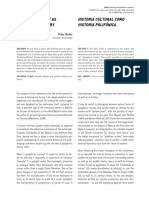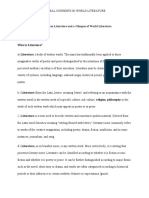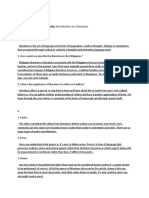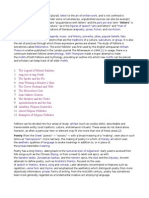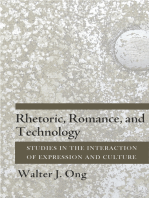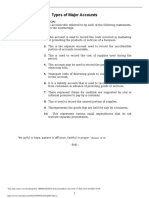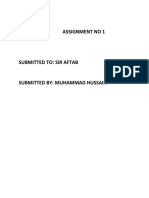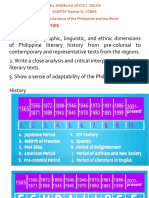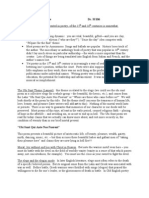Pre-Activity: Chapter I: Introduction To Literature
Pre-Activity: Chapter I: Introduction To Literature
Uploaded by
bbrightvc 一ไบร์ทCopyright:
Available Formats
Pre-Activity: Chapter I: Introduction To Literature
Pre-Activity: Chapter I: Introduction To Literature
Uploaded by
bbrightvc 一ไบร์ทOriginal Description:
Original Title
Copyright
Available Formats
Share this document
Did you find this document useful?
Is this content inappropriate?
Copyright:
Available Formats
Pre-Activity: Chapter I: Introduction To Literature
Pre-Activity: Chapter I: Introduction To Literature
Uploaded by
bbrightvc 一ไบร์ทCopyright:
Available Formats
Pre-
Activity
This is a primary activity administered to determine your baseline
knowledge and preparedness for the lesson.
Activity: Introduction to Literature
I. Direction: Answer the following questions.
1. What is literature?
Literature broadly is any collection of written work, but it is also used more
narrowly for writings specifically considered to be an art form, especially prose fiction,
drama, and poetry. The name has traditionally been applied to those imaginative works
of poetry and prose distinguished by the intentions of their authors and the perceived
aesthetic excellence of their execution. Literature may be classified according to a
variety of systems, including language, national origin, historical period, genre, and
subject matter. Deriving from the Latin littera, “a letter of the alphabet,” literature is first
and foremost humankind’s entire body of writing; after that it is the body of writing
belonging to a given language or people; then it is individual pieces of writing.
2. How would you describe the literature in the Philippines?
For me, Philippine literature is consists of many influences from other
country and region. From colonialization and other history events they mold us
as a Strong and independent country with a lot of learnings from them. Philippine
Literature is a long story that we say "its happened for a reason" to learn, aware
and understand our soroundings and open our mind on decision making. Its
certain a lot of efforts of our Pilipino hero that served and died for our country. 🙃
( Philippine literature is literature associated with the Philippines from prehistory,
through its colonial legacies, and on to the present. Pre-Hispanic Philippine literature
was actually epics passed on from generation to generation, originally through an oral
tradition. However, wealthy families, especially in Mindanao, were able to keep
transcribed copies of these epics as family heirloom. One such was the Darangen, an
epic of the Maranaos. Definition of Philippine Literature
There are various Filipino writers and interpreters who define literature in their views as
citizens of the Philippines. These included Jose Arrogante, Zeus Salazar, and
Patrocinio V. Villafuerte, among others. )
(Credit)https://www.hisour.com/philippine-literature-37337/
Chapter I: Introduction to Literature 1
3. What is the significance of literature to culture in tradition?
The humanities and social sciences help us to understand cultures through
historical and contemporary lenses. In the Literature, Culture and Tradition
concentration, you study and analyze the worldviews of different cultures, exploring
cultural change and continuity over time and place. Through historical, literary, and
cultural analysis of sources and artifacts, you develop research skills and learn to
evaluate complex cultures and scenarios. You also apply the same analytical
approaches to gain critical insights into current world challenges.The analytical and
communications skills gained in the Literature, Culture and Tradition concentration are
essential in any communications-related profession and in many business settings. In
one sense, literary tradition simply means such an accumulative process of handing
down texts for future generations. In another sense, however, tradition often involves a
selective process whereby the most important (most ‘valuable’) works are singled out as
the ones that each generation should know.
II. Direction: Explain the different types of literary genre.
1. Poetry
Poetry is a type of literature based on the interplay of words and rhythm. It often
employs rhyme and meter (a set of rules governing the number and arrangement of
syllables in each line). In poetry, words are strung together to form sounds, images, and
ideas that might be too complex or abstract to describe directly. Poetry was once written
according to fairly strict rules of meter and rhyme, and each culture had its own rules.
For example, Anglo-Saxon poets had their own rhyme schemes and meters, while
Greek poets and Arabic poets had others. Although these classical forms are still widely
used today, modern poets frequently do away with rules altogether – their poems
generally do not rhyme, and do not fit any particular meter. These poems, however, still
have a rhythmic quality and seek to create beauty through their words.
2. Prose
Prose is verbal or written language that follows the natural flow of speech. It is the
most common form of writing, used in both fiction and non-fiction. Prose comes from the
Latin “prosa oratio,” meaning “straightforward.”
In Writting, Prose refers to any written work that follows a basic grammatical
structure (think words and phrases arranged into sentences and paragraphs). This
stands out from works of poetry, which follow a metrical structure (think lines and
stanzas). Prose simply means language that follows the natural patterns found in
everyday speech.
Chapter I: Introduction to Literature 2
3. Drama
Drama in literature refers to the performance of written dialogue and stage
action. It’s a literary genre that allows actors to act out a writer’s words directly to an
audience. But there’s more than one type of literary genre – and chances are, you’ve
seen examples of them all. Here are some explanations and examples of different types
of drama in literature.
4. Non-fiction
“Nonfiction” refers to literature based in fact. It is the broadest category of
literature. The Nonfiction Department has books and videos in many categories
including biography, business, cooking, health and fitness, pets, crafts, home
decorating, languages, travel, home improvement, religion, art and music, history, self-
help, true crime, science and humor. We also have a section of popular and award-
winning documentary DVDs. Nonfiction is a broad genre of writing that encompasses all
books that aren’t rooted in a fictional narrative. Nonfiction writing can be based in history
and biography, it can be instructional, it can offer commentary and humor, and it can
ponder philosophical questions. If a book is not rooted in a made-up story, then it is
nonfiction.
5. Media
Media are the various material ways information can be communicated. The fields
of media studies and media theory are dedicated to the analysis and understanding of
the myriad media through which information is communicated. Under the influence of
these fields, the media through which literature is communicated is no longer
considered secondary to the literary content or form, but deserving attention in its own
right. Moreover, literary content and form can and often are deeply influenced by media
of their transmission, as well as by the particular forms of media prevalent at the time
and place of their production. The reception of literature can also be swayed by
dominant media forms. In what follows we will examine historical examples of the
relation between literature and media, as well as examples from a variety of cultural
contexts.
- Miravalles
Chapter I: Introduction to Literature 3
You might also like
- WHOLE MODULES - World LiteratureDocument127 pagesWHOLE MODULES - World Literaturexxxx100% (1)
- The River AnalysisDocument2 pagesThe River AnalysisNigel Lawai Willie50% (2)
- ICCT Colleges Foundation, Inc.: Profe01-Accounting For Special TransactionsDocument1 pageICCT Colleges Foundation, Inc.: Profe01-Accounting For Special Transactionsbbrightvc 一ไบร์ทNo ratings yet
- 03 Burke 2010 PDFDocument8 pages03 Burke 2010 PDFJair Adolfo Miranda TamayoNo ratings yet
- The Aeneid - Essay 1Document3 pagesThe Aeneid - Essay 1jeighedNo ratings yet
- Lecture OneDocument5 pagesLecture Oneamaniboughfir005No ratings yet
- Handouts in EL 106 Chapter 1Document26 pagesHandouts in EL 106 Chapter 1Arnie Marie PaclibarNo ratings yet
- USMKCC COL F 050b Chap 1 Intro LIT 111 INTRODUCTIONDocument13 pagesUSMKCC COL F 050b Chap 1 Intro LIT 111 INTRODUCTIONHoney ObelloNo ratings yet
- Complete Quarter 1 Modules and Selected ActivitiesDocument20 pagesComplete Quarter 1 Modules and Selected ActivitiesEmelyn Flores-FernandezNo ratings yet
- Pre-Activity #1 - Lite001 - Arizha CruzDocument2 pagesPre-Activity #1 - Lite001 - Arizha CruzArizha CruzNo ratings yet
- Philippine Literature RESEARCHDocument6 pagesPhilippine Literature RESEARCHNoraine Tugade100% (2)
- Intro-to-Phil-LitDocument38 pagesIntro-to-Phil-LitysterfayesyNo ratings yet
- Eng 4: Philippine LiteratureDocument5 pagesEng 4: Philippine Literaturejanela rodrigoNo ratings yet
- Act1 Lite001Document1 pageAct1 Lite001Johny bravoNo ratings yet
- Masterpieces of World LiteratureDocument3 pagesMasterpieces of World Literaturerichelle salesNo ratings yet
- Introduction To Philippine LiteratureDocument36 pagesIntroduction To Philippine LiteratureJohn Maglasang0No ratings yet
- Introduction To Philippine LiteratureDocument36 pagesIntroduction To Philippine LiteratureJohn Maglasang0No ratings yet
- Midterm Module 1 - The Take OffDocument4 pagesMidterm Module 1 - The Take OffZarielleNo ratings yet
- A Review On Literature and A Glimpse of World Literature-SongcuanDocument43 pagesA Review On Literature and A Glimpse of World Literature-SongcuanElliNo ratings yet
- 1a Chapter-1-Intro-LIT-111Document11 pages1a Chapter-1-Intro-LIT-111Bryan GounzoNo ratings yet
- Chap 1 Introduction EditedDocument10 pagesChap 1 Introduction EditedRhomel John PadernillaNo ratings yet
- Unit 37Document8 pagesUnit 37Ardnas AtsocNo ratings yet
- New Rich Text DocumentDocument2 pagesNew Rich Text DocumenttaehyungNo ratings yet
- 21st Century Modular ActivitiesDocument19 pages21st Century Modular ActivitiesMaricar De GuzmanNo ratings yet
- World LiteratureDocument76 pagesWorld LiteratureAgom KoNo ratings yet
- Course Intended Learning OutcomesDocument12 pagesCourse Intended Learning OutcomesJasminConejeroNo ratings yet
- Chapter 1 Pre-ActivityDocument2 pagesChapter 1 Pre-ActivityKen Christian GonzalesNo ratings yet
- Literature SummaryDocument14 pagesLiterature SummaryJoela CastilNo ratings yet
- World Literature: Prepared byDocument22 pagesWorld Literature: Prepared byLJ MermidaNo ratings yet
- Aika's Document - Word LiteratureDocument29 pagesAika's Document - Word LiteratureAiicah Zack Harris LanceNo ratings yet
- 21st Century Literature From The Philippines and The WorldDocument5 pages21st Century Literature From The Philippines and The WorldMonique BusranNo ratings yet
- World Lit For GEE LMSDocument66 pagesWorld Lit For GEE LMSMary Joyce Servano100% (1)
- GEC14 Lecture 1Document61 pagesGEC14 Lecture 1Mary Jane de joyaNo ratings yet
- 21st CenturyDocument3 pages21st CenturySidney Viel MañagoNo ratings yet
- Introduction To Philippine LiteratureDocument27 pagesIntroduction To Philippine LiteratureEsmeralda ViaNo ratings yet
- Unit 1 World LiteratureDocument5 pagesUnit 1 World LiteratureDh OngNo ratings yet
- Activity 1 LiteratureDocument2 pagesActivity 1 Literature성공한JayNo ratings yet
- Lesson 1 Introduction To Lit PhilippineDocument14 pagesLesson 1 Introduction To Lit PhilippineAjay CarandanNo ratings yet
- Module 1Document3 pagesModule 1polyNo ratings yet
- Fundamentals of LiteratureDocument28 pagesFundamentals of LiteratureTesfu Hetto50% (2)
- 4127 Bla 1111 Critical Reading and Response NotesDocument53 pages4127 Bla 1111 Critical Reading and Response NotesXusseney AxmedNo ratings yet
- Elements and Contexts of 21st Century Philippineliterature Week 1Document18 pagesElements and Contexts of 21st Century Philippineliterature Week 1Scylla Shadow of DeceptionNo ratings yet
- Basic Concepts of LiteratureDocument5 pagesBasic Concepts of LiteratureJosafatNo ratings yet
- Prose Group 1Document14 pagesProse Group 1DeevaniaNo ratings yet
- GEE 19 Learning Materials 22 23Document56 pagesGEE 19 Learning Materials 22 23JOHN BEL SAMBAYANNo ratings yet
- Literature PptDocument23 pagesLiterature Pptbarcomajesnill.hNo ratings yet
- Literary Theories A (2) - 1Document138 pagesLiterary Theories A (2) - 1Amber MerseyNo ratings yet
- St. Anthony College Calapan City, Inc.: Information Sheet 1.3 Introduction To Literature Learning OutcomesDocument8 pagesSt. Anthony College Calapan City, Inc.: Information Sheet 1.3 Introduction To Literature Learning OutcomesxxxxNo ratings yet
- 21st Century LiteratureDocument4 pages21st Century LiteratureAbsNo ratings yet
- Lecture 1-Document4 pagesLecture 1-Ilyas BallaNo ratings yet
- Two Types of Literature Are Written and OralDocument63 pagesTwo Types of Literature Are Written and OralJomar Rebulado80% (5)
- Etemological MeaningDocument4 pagesEtemological MeaningLeo MagadanNo ratings yet
- WORLD LITERATURE - Prelim and MidtermDocument21 pagesWORLD LITERATURE - Prelim and MidtermArchLaurence SanchezNo ratings yet
- Pars Pro Toto: LiteratureDocument3 pagesPars Pro Toto: LiteratureDe Jesus Paola KristinaNo ratings yet
- 11920231009516537LIT2 - Module 1 - Lesson 1Document22 pages11920231009516537LIT2 - Module 1 - Lesson 1Kenneth AbatonNo ratings yet
- G11 - 21ST Century - Month of JanuaryDocument7 pagesG11 - 21ST Century - Month of Januaryjamessuma12345No ratings yet
- What Is Literature?: DR Rubina Sheikh SPRING 2024 Class 1 JAN 22, 2024Document18 pagesWhat Is Literature?: DR Rubina Sheikh SPRING 2024 Class 1 JAN 22, 2024zohaali2810No ratings yet
- Week 3 & 4Document5 pagesWeek 3 & 4divya brahmaNo ratings yet
- PresentaDocument16 pagesPresentaAnneilyn LealNo ratings yet
- Literature:: 1. Expanding HorizonsDocument9 pagesLiterature:: 1. Expanding HorizonsJustine Rose AngolluanNo ratings yet
- Topic Areas in Literature Studies-DindaDocument14 pagesTopic Areas in Literature Studies-DindaUmi FauziahNo ratings yet
- LiteratureDocument2 pagesLiteratureLara Kim PerezNo ratings yet
- Importance of LiteratureDocument3 pagesImportance of LiteratureLuzviminda ManaloNo ratings yet
- Rhetoric, Romance, and Technology: Studies in the Interaction of Expression and CultureFrom EverandRhetoric, Romance, and Technology: Studies in the Interaction of Expression and CultureNo ratings yet
- (Done) Activity-Chapter 2Document8 pages(Done) Activity-Chapter 2bbrightvc 一ไบร์ทNo ratings yet
- COVID19 Sore Throat Now The Most Common Coronavirus Symptom, Data SuggestsDocument3 pagesCOVID19 Sore Throat Now The Most Common Coronavirus Symptom, Data Suggestsbbrightvc 一ไบร์ทNo ratings yet
- This Study Resource Was: Miscellaneous TopicsDocument2 pagesThis Study Resource Was: Miscellaneous Topicsbbrightvc 一ไบร์ทNo ratings yet
- Types of Major AccountsDocument6 pagesTypes of Major Accountsbbrightvc 一ไบร์ทNo ratings yet
- ICCT Colleges Foundation, Inc.: Profe01-Accounting For Special TransactionsDocument3 pagesICCT Colleges Foundation, Inc.: Profe01-Accounting For Special Transactionsbbrightvc 一ไบร์ทNo ratings yet
- ICCT Colleges Foundation, Inc.: Income Taxation - CBTAX01Document3 pagesICCT Colleges Foundation, Inc.: Income Taxation - CBTAX01bbrightvc 一ไบร์ทNo ratings yet
- Chapter Iii - Learning Task - Literature in Car and NCRDocument2 pagesChapter Iii - Learning Task - Literature in Car and NCRbbrightvc 一ไบร์ทNo ratings yet
- New Curriculum Spanish DeptDocument94 pagesNew Curriculum Spanish DeptKhan Mohammad Mahmud HasanNo ratings yet
- (Resources in Arabic and Islamic Studies 8) Roger Allen - Selected Studies in Modern Arabic Narrative - History, Genre, Translation (2018, Lockwood Press)Document227 pages(Resources in Arabic and Islamic Studies 8) Roger Allen - Selected Studies in Modern Arabic Narrative - History, Genre, Translation (2018, Lockwood Press)FlorentNo ratings yet
- Lesson 3 - Variations of LanguageDocument17 pagesLesson 3 - Variations of LanguageIvy Mae SagangNo ratings yet
- The Fiction One Is inDocument61 pagesThe Fiction One Is inRandall Green100% (1)
- AssignmentDocument6 pagesAssignmentMuhammad HussainNo ratings yet
- 320 (0) 3rd YearDocument2 pages320 (0) 3rd Yearalimehmet53886No ratings yet
- Features of Prose Detailed Lesson PlanDocument15 pagesFeatures of Prose Detailed Lesson Planalvin madahanNo ratings yet
- Notre Dame of Salaman College Inc.: Course Description: (CMO)Document2 pagesNotre Dame of Salaman College Inc.: Course Description: (CMO)Aillen Grace Azucena DayagNo ratings yet
- Abrams M HDocument51 pagesAbrams M HalexNo ratings yet
- Roald Dahl's Life (About The Author) PDFDocument9 pagesRoald Dahl's Life (About The Author) PDFOjeda ThomasNo ratings yet
- Second GenerationDocument2 pagesSecond GenerationEdoardo PessinaNo ratings yet
- Edmund SpenserDocument2 pagesEdmund SpenserPradyumna KansariNo ratings yet
- BorgesDocument276 pagesBorgesgokhan1313100% (2)
- NRP Grade 7Document24 pagesNRP Grade 7sanandresmariannekayeNo ratings yet
- Lesson 1.1 Geographic, Linguistic and Ethnic Dimensions of Philippine Literary History From Pre-Colonial To The ContemporaryDocument34 pagesLesson 1.1 Geographic, Linguistic and Ethnic Dimensions of Philippine Literary History From Pre-Colonial To The Contemporaryʟᴏғɪ.No ratings yet
- Demeter MourningDocument2 pagesDemeter MourningJamieNo ratings yet
- CLAS 151g F 2016 SyllabusDocument8 pagesCLAS 151g F 2016 SyllabusJeremy HongNo ratings yet
- First Quarter PortfolioDocument20 pagesFirst Quarter Portfolioapi-168501117No ratings yet
- The Elson Readers, Book 5 by Elson, William H.Document287 pagesThe Elson Readers, Book 5 by Elson, William H.Gutenberg.orgNo ratings yet
- AtonementDocument3 pagesAtonementMirela Strajeriu Hrimiuc100% (1)
- Week 1 Lecture Thursday - Madrigal.balladDocument3 pagesWeek 1 Lecture Thursday - Madrigal.balladKamran PaksereshtNo ratings yet
- OzymandiasDocument13 pagesOzymandiasQuantaviousNo ratings yet
- Childe Harold by G. G. ByronDocument2 pagesChilde Harold by G. G. ByronMarina VasilicNo ratings yet
- How To Plan Your NovelDocument15 pagesHow To Plan Your NovelBarrón ZarzaNo ratings yet
- Book ListDocument4 pagesBook ListtimiosNo ratings yet
- Collecting Indian Graphic Novels-Clyde D'melloDocument6 pagesCollecting Indian Graphic Novels-Clyde D'melloManojNo ratings yet
- Thomas Stearns EliotDocument9 pagesThomas Stearns EliotАнужин Д.No ratings yet
